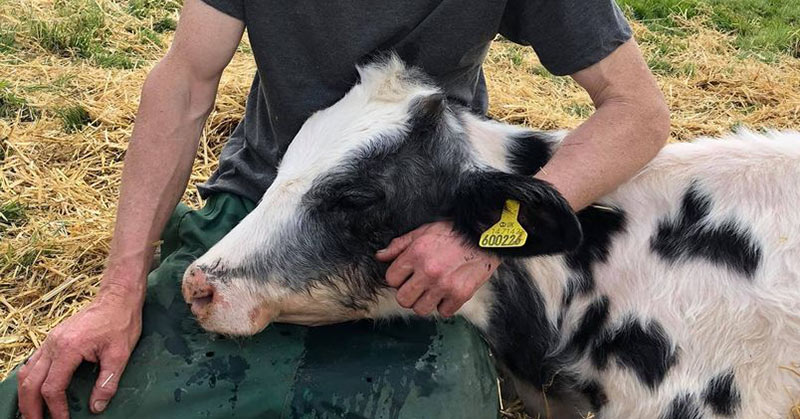It’s a common sight- garbage tossed into the ditch on a roadside, trash blowing across our sidewalks and getting caught in sewer drains, and wrappers, plastic bags, and even clothing flowing down our rivers and streams. It’s sad but true- many people operate with the “out of sight, out of mind” mentality, and carelessly dispose of their refuse wherever and whenever they like, never stopping to think about where that trash is going to end up, and whom it might impact. And now, the impact is clear after a calf died after eating a balloon.
One farming family has witnessed first-hand the devastating impact that even one piece of garbage can have, and wants everyone to think before they simply toss something to the ground.
Lisa the Baby Cow died after eating a balloon
Lisa was a six-month-old baby cow living in Lincolnshire in the UK. Her owners, Sharon Ley and her husband, Adrien, had brought her to the farm for one of their cows who had lost her own baby six months prior.
After a passerby notified them that they had seen a cow staggering around in the field, baby Lisa was taken to the vet where they found out something she had eaten had gotten lodged in her bowel. They later found out that the calf had ingested a discarded birthday balloon.
“There was nothing we could do,” said Ley. “Cows have several stomachs and it had gone too far.” [1]
Sharon, Adrian, and their thirteen-year-old foster daughter brought Lisa back to the field, and tried to make her as comfortable as possible, hoping that she would pull through.
“We were using a bucket and cup to give her water as she couldn’t keep her head up. We went up everyday with our foster daughter,” Ley said [1].
Five days later, little Lisa passed away with her mother licking her, trying to wake her up. The calf had died after eating a balloon.
“She wouldn’t leave her side. When we were taking Lisa away her mum was running around the tractor trying to get it to stop.” [1]
The family is devastated, especially knowing that this was a needless and easily-preventable death. Ley says that while she knows sometimes balloons accidentally get let go of, there are those who simply let them go without any idea as to where they’ll land. She noted that before they put the cows in that pasture, her fiance went around and was able to fill an entire bin with the trash that had been thrown from the road.
“People need to be more conscious of what they’re doing. If they land in a field like this one has then a cow or a deer or some other animal will eat it and will die,” she lamented. “It’s unbelievable what people will throw away. We should be looking after our planet.”
The Dangers of Littering
Sadly, Lisa, the calf is just one example of the dangers that are created by littering.
Car accidents are a major concern when it comes to littering. Even one piece of trash can cause a collision, whether it’s a small car driving over something sturdier, like a wooden crate, or a larger vehicle swerving to miss a piece of garbage on the road and losing control.
Littering also degrades natural areas and can kill plants and other wildlife. Images of turtles and birds being caught in a soda can ring can be found all over the internet, with their bodies permanently misconfigured, which will eventually lead to death.
Additionally, litter can destroy our water quality. Hazardous waste can seep into the soil, which eventually leads to groundwater pollution. This can poison the wildlife and vegetation that survive in water, and can lead to human illness as well.
Littering is also an expensive problem. Millions of dollars must be spent every year to clean up litter in communities around the world, and additional funds must be spent in order to filter and clean contaminated water for us to use in our homes [2].
How Can You Help
You can have a direct impact on this problem by simply not littering. If we all ensure that we are disposing of waste properly, it will not end up in farmers’ fields where it can be unwittingly ingested by unsuspecting cows or other animals.
Of course, reducing the amount of garbage you create is another excellent step toward creating a cleaner environment. Garbage, depending on what it is, can take ten to hundreds of years to break down, and the overflow of waste that we have built up in landfills around the world is creating a significant environmental problem.
The World Wildlife Fund encourages everyone to think about where a piece of garbage might end up every time you throw it away, especially with items like old cell phones or used batteries, that are made of mercury and plastic- both of which are hazardous to the environment [3].
The United States Environmental Protection Agency (EPA) provides detailed information about different types of waste and how they affect the environment and provides resources for how hazardous materials can be disposed of properly.
As mentioned, however, the most important thing is to reduce the amount of garbage we generate overall. This means reducing our reliance on single-use items, reusing whenever we can, repairing things instead of throwing them away and replacing them with something new, and recycling whenever possible.
Keep Reading: Company Collects 80% of City’s Recyclable Plastics and Turns It All into Lumber

